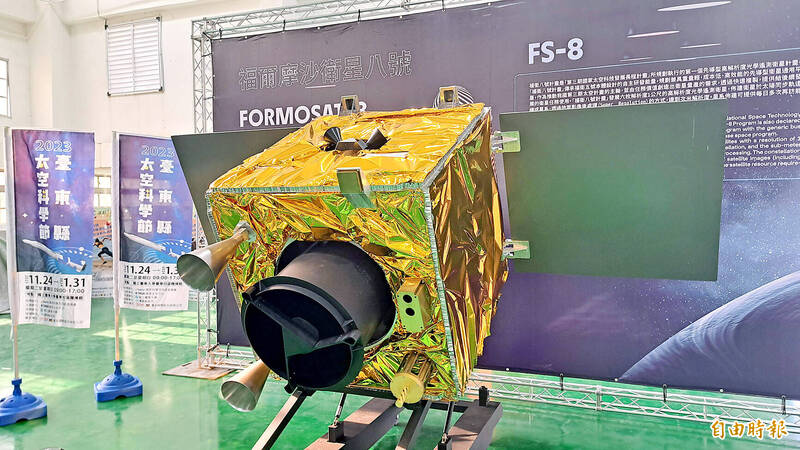《TAIPEI TIMES》Formosat-8 to contain Taiwan-made sensors

A mock-up of a Formosat-8 satellite is pictured in an undated photograph. Photo: Huang Ming-tang, Taipei Times
SPACE TECHNOLOGY:Formosat-8 is a light, low-cost, but highly efficient satellite platform developed by Taiwanese engineers, project manager Cynthia Liu said
By Wu Po-hsiung and Chen Chia-yi / Staff Reporters
The Formosat-8 satellite program would be equipped with eight Taiwan-made high-resolution optical remote sensing satellites and an artificial intelligence (AI) system, with one satellite launched annually over the next seven years, the Taiwan Space Agency (TASA) said.
In its draft of the third phase of the national space technology development project, which was submitted to the Executive Yuan at the end of last month, the National Science and Technology Council proposed to extend the project’s expiration date from 2028 to 2031, with the funding for the project expanding to NT$40 billion (US$1.2 billion).
The main tasks of the project would be to develop high-resolution optical remote sensing satellites and low Earth orbit satellites. The Formosat-8 is a pilot project for high-resolution optical remote sensing satellites, which would also be the nation’s first satellite equipped with an AI system.
Based on TASA’s plan, Formosat-8, like Formosat-5, would be a light, low-cost, but highly efficient satellite platform designed and developed by Taiwanese engineers. Formosat-8 project manager Cynthia Liu (劉小菁) said the project would build a total of eight remote sensing satellites, with six of them having the ability to capture high-resolution images of objects 1m above ground from an altitude of about 561km.
“Post-processing” of the satellite images would show those of items 0.7m above ground, Liu said, adding that the resolution of the last two satellites would allow them to capture images under 1m above ground, she said.
The first remote sensing satellite — FS-8A — has completed a thermal vacuum test, Liu said, adding that it is scheduled to be launched into space in the fourth quarter of this year on a SpaceX rocket.
One satellite would be launched annually over the next seven years, she said.
The National Atomic Research Institute has also been researching the development of domestically produced solar cells, which are scheduled to be launched into space along with a second remote-sensing satellite in 2027.
If the solar cells are certified, the percentage of the satellite components made in Taiwan would be increased, Liu said.
“As countries around the world step up competition in the space age, solar panels that could be used in space are expected to be in high demand, she said.
“If we have the technology, we can develop the space industry further, and more countries would place orders for Taiwan-made solar cells,” she added.
新聞來源:TAIPEI TIMES













